We can add angles and get the result of their sum, and we can also subtract them to find the difference between them.
Even if the angles don't have any numbers, we'll learn how to represent their sum or difference and arrive at the correct result.
Sum and Difference of Angles
Sum and Difference of Angles
Angle Sum
To find the sum of angles, they must have a common vertex.
Difference Between Angles
Just as we have added angles, we can also subtract one from another.
We can say that:
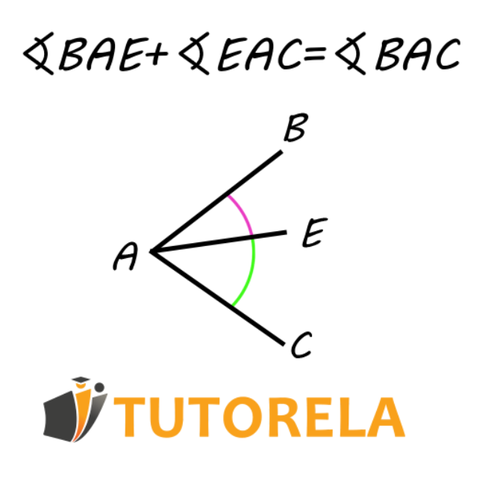
Test yourself on sum and difference of angles!
Indicates which angle is greater
Even if angles don't have any numbers, we'll learn how to represent their sum or difference and arrive at the correct result: the correct naming of the angle we get as a result.
Don't worry, the sum and difference of angles is not a difficult topic and mainly relies on the representation of the angles.
Don't know how to correctly mark angles? Go practice representing angles and come back with 90% success!
Let's look at the following example
We can say that:

It is known that the whole is composed of the sum of its parts, and the same is true with angles.
The large angle A) is made up of the two angles it contains.
If we add the 2 angles that make up angle A), we will obtain this angle.
If we know the size of the angles, we can, with a simple mathematical operation, discover the real value of angle A).
For example, having the following:
and we were asked to calculate:
which is actually the large angle A) that contains the two given angles inside,
all we have to do is add the values of the given angles and find the one we were asked to discover.
We can say that:
Difference Between Angles
Just as we have added angles, we can also subtract one angle from another.
Let's look at the following example:
If we know that:
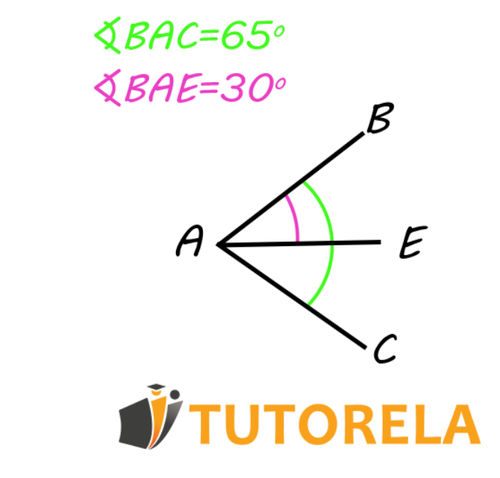
What will be the value of ?
Since angle contains the angles and and is composed only of these two,
we can subtract the given angle from the larger angle to find the angle .
That is:
Remember: The whole is composed of the sum of its parts!
We can add and subtract angles that are on the same vertex without any problem.
Just pay attention to do it the right way and know how to read the names of the angles.
Indicates which angle is greater
Which angle is greater?
Indicates which angle is greater
Angle Sum and Difference Exercises
Exercise 1
Assignment
Calculate the value of
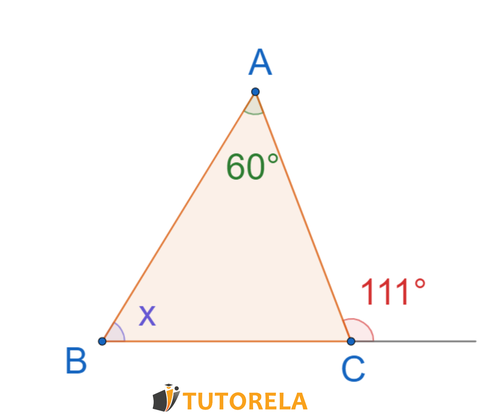
Solution
We calculate
Now we calculate
Remember that the sum of all angles in a triangle equals
Answer
Exercise 2
Assignment
Given the angles between parallel lines in the graph, what is the value of: ?
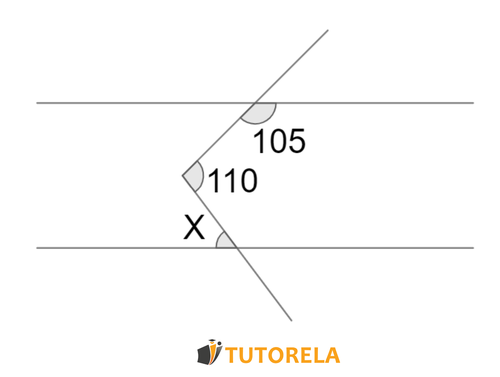
Solution
Answer
Which angle is greatest?
Indicates which angle is greater
Shown below is the right triangle ABC.
\( ∢\text{BAC}=55° \)
Calculate the angle \( ∢\text{ACB} \).
Exercise 3
Prompt
Given the parallel lines
Find the angle
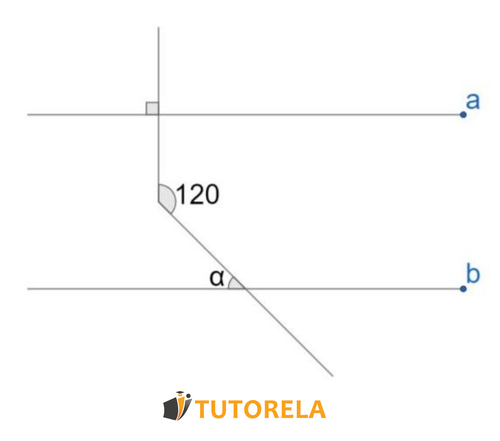
Solution
We extend the vertical line to the end and label the adjacent angles and: with on the left and: on the right
Now we notice that the angle is a corresponding angle to: and since adjacent angles sum up to: , then the angle is also equal to:
The remaining angle in the small triangle we created, which is also adjacent to: is called
As it is adjacent to: it will be equal to: since it is complementary to:
Now we calculate the sum of angles in the small triangle:
We replace with the data we know
We move the terms
Answer
Exercise 4
Assignment
is a triangle
Based on the information, what is the size of the angle
of value ?

Solution
First, we calculate the angle
Now let's find the angle
Now we refer to the triangle
Answer
What is the size of the missing angle?
What is the size of angle ABC?
What is the size of the unlabelled angle?
Exercise 5
Assignment
Calculate the values of and

Solution
We refer to triangle
Let's find the angle
Now we refer to triangle
Let's find the angle
Answer
Find the measure of the angle \( \alpha \)
Determine the size of angle ABC?
DBC = 100°
Calculate the size of the unmarked angle:
Examples with solutions for Sum and Difference of Angles
Exercise #1
Indicates which angle is greater
Video Solution
Step-by-Step Solution
Answer B is correct because the more closed the angle is, the more acute it is (less than 90 degrees), meaning it's smaller.
The more open the angle is, the more obtuse it is (greater than 90 degrees), meaning it's larger.
Answer
Exercise #2
Indicates which angle is greater
Video Solution
Step-by-Step Solution
In drawing A, we can see that the angle is an obtuse angle, meaning it is larger than 90 degrees:
While in drawing B, the angle is a right angle, meaning it equals 90 degrees:
Therefore, the larger angle appears in drawing A.
Answer
Exercise #3
Which angle is greatest?
Video Solution
Step-by-Step Solution
In drawing A, we can see that the angle is more closed:
While in drawing B, the angle is more open:
In other words, in diagram (a) the angle is more acute, while in diagram (b) the angle is more obtuse.
Remember that the more obtuse an angle is, the larger it is.
Therefore, the larger of the two angles appears in diagram (b).
Answer
Exercise #4
What is the size of angle ABC?
Video Solution
Step-by-Step Solution
In order to calculate the value of angle ABC, we must calculate the sum of all the given angles.
That is:
Answer
110
Exercise #5
Find the measure of the angle
Video Solution
Step-by-Step Solution
It is known that the sum of angles in a triangle is 180 degrees.
Since we are given two angles, we can calculate
We should note that the sum of the two given angles is greater than 180 degrees.
Therefore, there is no solution possible.
Answer
There is no possibility of resolving
More Questions
Sum and Difference of Angles
- Triangle Angle Analysis: Can 30°, 60°, and 90° Form a Valid Triangle?
- Triangle Angle Verification: Do 56°, 89°, and 17° Form a Valid Triangle?
- Calculate Angle X in Straight Line: Given 41° and 45° Angles
- Find the Missing Angle in a 65° Circular Sector: Geometric Calculation
- Triangle Angle Problem: Can 90, 115, and 35 Degrees Form a Triangle?
- Area
- Trapezoids
- Area of a trapezoid
- Perimeter of a trapezoid
- Parallelogram
- The area of a parallelogram: what is it and how is it calculated?
- Perimeter of a Parallelogram
- Kite
- Area of a Deltoid (Kite)
- Parallel lines
- Angles In Parallel Lines
- Alternate angles
- Corresponding angles
- Collateral angles
- Vertically Opposite Angles
- Adjacent angles
- Rectangle
- Calculating the Area of a Rectangle
- The perimeter of the rectangle
- Congruent Rectangles
- The sides or edges of a triangle
- Triangle Height
- Angle Notation
- Angle Bisector
- Right angle
- Acute Angles
- Obtuse Angle
- Plane angle
- The Sum of the Interior Angles of a Triangle
- Perpendicular Lines
- Exterior angles of a triangle
- Perimeter
- Triangle
- Types of Triangles
- Obtuse Triangle
- Equilateral triangle
- Identification of an Isosceles Triangle
- Scalene triangle
- Acute triangle
- Isosceles triangle
- The Area of a Triangle
- Area of a right triangle
- Area of Isosceles Triangles
- Area of a Scalene Triangle
- Area of Equilateral Triangles
- Perimeter of a triangle
- Areas of Polygons for 7th Grade
- Right Triangle
- Area of a right-angled trapezoid
- Area of an isosceles trapezoid
- Corresponding exterior angles
- Alternate interior angles
- Median in a triangle
- Center of a Triangle - The Centroid - The Intersection Point of Medians
- How do we calculate the area of complex shapes?
- How to calculate the area of a triangle using trigonometry?
- How do we calculate the perimeter of polygons?
- All terms in triangle calculation
- Types of angles (right, acute, obtuse, straight)









